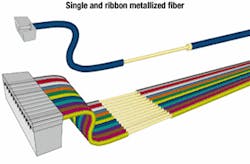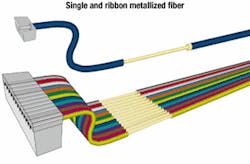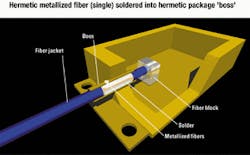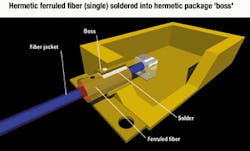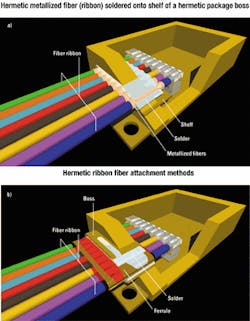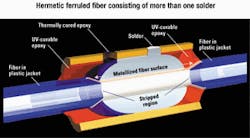Packaging - Hermetic packaging: a neglected 'Holy Grail'?
The following techniques can allow hermetic packaging to be used for a variety of components.
GLENN OGURA, Resonetics Corp.
Packaging is one of the "Holy Grails" of fiber optics. A hermetic package is designed to prevent moisture from entering the package, measured at levels of 1x10-8 atm-cc/sec-He or lower. Hermetic packaging designs for fiber optics are based on proven packaging principles borrowed from the microelectronics and microwave industries. However, there has been less public attention on packaging because fiber-optic companies have concentrated their research and development on the "black box" itself-and rightly so. From a priority standpoint, why worry about how the device will be packaged if there is no device at all?
But in today's marketplace, hermetic packaging is becoming a big deal, because technology alone won't persuade network gear companies to select one component over another. The guarantee of reliability, without any additional costs, is becoming the mantra of both network suppliers and the consumer.
Electronics, epoxy, and sensitive micro-electromechanical systems (MEMS) devices are three reasons fiber-optic components are hermetically sealed. For active devices such as lasers, modulators, variable optical attenuators (VOAs), amplifiers, and detectors, the electronic contacts or electrodes will corrode over time if exposed to prolonged moisture, eventually resulting in device failure. A pigtail attachment to a wafer or chip, such as an array waveguide or planar lightwave circuit, can shift due to the moisture-sensitive epoxy, resulting in fiber misalignment. And lastly, optical subcomponents such as filters, mirrors, and MEMS devices are very susceptible to moisture, potentially degrading their optical characteristics.
A few trends have emerged that motivate fiber-optic-component designers to consider a hermetic package.
First, if a network equipment supplier discovers that a fiber-optic component in a DWDM system has failed and that the component in question was not hermetically sealed, then doubt is cast over the component's reliability. In truth, the actual failure may not be moisture-related at all, but hermetic packaging eliminates that avenue immediately. In today's competitive marketplace, a hermetic package will offer an additional level of security for the end customer.
Second, the industry's trend toward integration of passive and active devices will result in packages that were originally designed for passives only being redesigned as hermetic, because they need to be actively controlled or monitored via a closed-loop feedback. Examples include an integrated laser, VOAs, and a power feedback monitor or a variable, tunable filter that can be dynamically changed.
Telcordia Reliability Specifications, such as GR-1209, -1221, or -468, imply that fiber-optic components must be reliable in the field for more than 20 years. That level of confidence is reached by subjecting components to extensive environmental tests such as thermal shock, temperature cycling, damp heat, mechanical shock and vibration, and tensile pull, among others. Depending on the actual device, optical properties such as insertion loss, polarization dependent loss (PDL), and backreflection are measured. Hermetic packaging can make it easier to pass such tests.
One of the challenges of hermetic packaging is the creation of a hermetic seal at the point where the optical fiber is traversing the package wall. Although the plastic coating of an optical fiber is adequate for the protection of the fiber itself from typical environmental and mechanical disturbances, it is not sufficient to provide a moisture barrier tight enough for the components inside the hermetic package.
Therefore, the optical fiber must be stripped to expose the glass cladding, which is subsequently coated with a thin solderable metal film. Then the metallized fiber is soldered into the wall of the package, either directly into a "boss" integral to the package or via an intermediate ferrule soldered into such a boss.
Also, there has been activity to create the hermetic seal by using special epoxies or glass solders. The long-term reliability of epoxy seals and the low mechanical strengths of glass solders are issues that still need to be addressed. For traditional glass/ metal seals, a key question revolves a round improving the technology. In the past, pigtail assemblies employed fibers metallized over the entire stripped-off region. That created handling and reliability difficulties due to the decreased strength of fibers and the absence of a protective coating.A recent development is a process called the Reso-strip, which uses a laser to strip the optical fiber mid-span so that only a small section of the fiber needs to be metallized and/or ferruled. In addition, the Reso-strip process provides repeatable, high-tensile-strength fibers compared to other techniques such as mechanical, chemical, or thermomechanical stripping.
Therefore, a mid-span metallized fiber, whether single or ribbon, eliminates the handling issues since the glass/metal seal occurs only at the entrance to the package. As a result, the hermetic seal has high tensile strength, while maintaining a flexible pigtail connection to the device-ideal for added strain relief (see Figure 1).Let's look at utilizing metallized, mid-span Reso-stripped fibers to identify the specific techniques to provide a hermetic seal.
There are two methods of providing a hermetic seal for a single optical fiber. The fiber can be mid-span metallized so that it can be inserted into a "boss" of a package (see Figure 2). The boss is a feed-through tube that is an integral part of the package and is normally welded or brazed to the package wall. Once the hermetic metallized fiber (HMF) is soldered into the boss, the hermetic seal is achieved.Alternatively, the metallized fiber can be packaged into a ferrule to create a hermetic ferruled fiber (HFF) that is later soldered into the boss (see Figure 3). The decision to choose an HMF or HFF depends on the packaging size constraints, device type, and manufacturing procedure.
The HMF has the advantage of not having a ferrule, which reduces the size of the hermetic seal to the outside diameter of the glass cladding itself and eliminates one soldering procedure. Although a ferruled fiber (HFF) requires more physical space due to the ferrule itself, it has the advantage of being easier to handle, giving the operator more freedom to manipulate the pigtail assembly safely by holding the protective ferrule itself.
There are a few methods for hermeti cally sealing a ribbon fiber into a package. A mid-span, metallized ribbon fiber (HMF) is soldered to a shelf integral to the package wall. Typically, a solder paste is applied to solder the wide metallized region to the package shelf (see Figure 4a). Alternatively, the mid-span metallized ribbon fiber is first soldered into a ribbon ferrule (HFF), allowing the user to solder the resulting subassembly into the package wall (see Figure 4b).The shelf concept requires a smaller package size than the ribbon ferrule. But the actual soldering of the HMF to the shelf can be tedious and subject to handling issues, since the wettability time can be quite long and often dependent on the operator's skill. Ribbon ferrules can be designed with flat, elliptical, or more traditional cylindrical outer profiles. The latter conforms more easily to standard cylindrical bosses but requires more physical space than an elliptical ribbon ferrule, especially for wide ribbons.
Whether a metallized fiber (HMF) or a ferruled fiber (HFF) is selected, soldering to the package wall creates the final hermetic seal of the package. There are a number of key issues that help determine the right solder selection: temperature, coefficient of thermal expansion, and wetting time.Temperature. As a general rule, it is advisable to select solder of low/moderate melting temperature if the packaging design allows it. The advantage of lower temperatures is the reduced risk of damaging the plastic buffer of the fiber or affecting any temperature-sensitive components within the device. For simplicity, solder temperatures can be divided into three categories: low, moderate, and high (see the Table on this page).
Low-temperature solders tend to be softer and offer advantages when filling a large solder volume, providing a more uniform expansion with reduced me chanical stress. However, they may not be applicable when soldering a metallized fiber into a ferrule (to create an HFF), because the next solder temperature required to attach the HFF to the package, which has to be 30-40°C lower to avoid reflow, would be too close to the upper operational limit of the device. As a rule of thumb, this second soldering temperature should be an additional 30-40°C above the highest temperature the package will see in operation or during accelerated environmental testing.
Coefficient of thermal expansion. The device in question influences the material selection of the ferrule, boss, shelf, or package wall. For example, to match lithium niobate, the coefficient of thermal expansion (CTE) of stainless steel is closer than kovar's. On the other hand, kovar's CTE is closer to fused silica than stainless steel. For incompatible materials, an optimum has to be found between the solder's ability to withstand strains and its tensile strength. That's becoming more common as fiber-component manufacturers strive to reduce packaging costs by using such packages as gold-plated aluminum.
Wetting time. There are many techniques to flow the solder, including hand irons, point soldering, infrared laser, micro-flame, hot air, inductance, and ultrasonic. The type and configuration of the hermetic fiber (HMF or HFF) and the package determine the method. In addition, some methods are more conducive to automated manufacturing than others. One of the key parameters is the amount of time required to melt and flow the solder. For example, soldering an HMF ribbon fiber to a shelf will take more time than soldering a single ferrule fiber. Therefore, a solder may be selected that can be flowed at lower temperatures so the extended wetting time does not adversely affect the device.
Success or failure of a hermetic package can only be proven by successfully passing a helium leak rate test after going through rigorous environmental testing. These tests, defined by Telcordia specifications, require several months and occupy significant resources. To maximize the chances of a successful hermetic design and re duce time-to-market, certain design guidelines are helpful. But these guidelines are by no means all-encompassing since there are many packaging variations in today's marketplace:
- Gold concentration. If too much gold is "leeched" out from the nickel-gold plating of the package and the fiber into the molten solder, then a gold-rich area within the seal can form, potentially creating a brittle joint. As a general rule, the gold concentration should not exceed 3-4% and can be monitored by electron dispersive spectroscopy after joint cross section. From this point of view, higher solder volumes and/or low gold-plating thickness ratio is desired. Most of this leeching occurs during soldering, but it also continues, albeit slowly, during operation at normal temperatures.
- Concentricity. The metallized fiber (HMF) should be positioned coaxial with the boss's or ferrule's inner diameter to avoid collapsing the solder thickness locally to a level that may lead to excess gold concentration or insufficient solder flow. This rule also applies to centering of ferruled fibers (HFF) within a boss. Proper tooling can solve this issue.
- Ferrule design. The mechanical tensile strength and bend radius of the hermetic pigtail assemblies are important measures of a successful design. These two parameters are normally tested before and after environmental exposure to ensure a reliable de sign. As shown in Figure 5, an HFF consists of more than just solder. In some designs, a thermal epoxy is inserted to im prove the overall mechanical strength, providing a strong bond between the plastic buffer, glass cladding, and ferrule. A flexible UV epoxy is often added at either end to provide necessary bend strain relief. Reliability is further improved with true mid-span metallization, allowing the original fiber to remain jacketed and thus strong outside the actual glass/metal seal.
As fiber moves closer to the home, controlled system environments become cost-prohibitive. Therefore, fiber-optic-component designers are faced with a daunting task of lowering packaging costs while improving the level of reliability. At first glance, these two trends seem to be diametrically opposite. But upon closer review, it is clear that cost and ultra-reliability will converge in the same manner as it did in the microelectronics industry.
As fiber-optic-component manufacturers continue to integrate functions together, such as planar waveguide circuits, MEMS, and hybrid designs, current non-hermetic components will be packaged together into a single hermetic enclosure. With so much added value, reliability will become paramount. As a result, the network companies, and ultimately the consumer, will obtain what is necessary-that is, better performance, higher functionality, lower price, and guaranteed reliability, compliments of a hermetic package.
Glenn Ogura is vice president of marketing at Resonetics Inc., Optical Connectivity Group (Nashua, NH), and he can be reached at [email protected]. He wishes to acknowledge the technical contribution of the Optical Connectivity Product Group at Resonetics.
